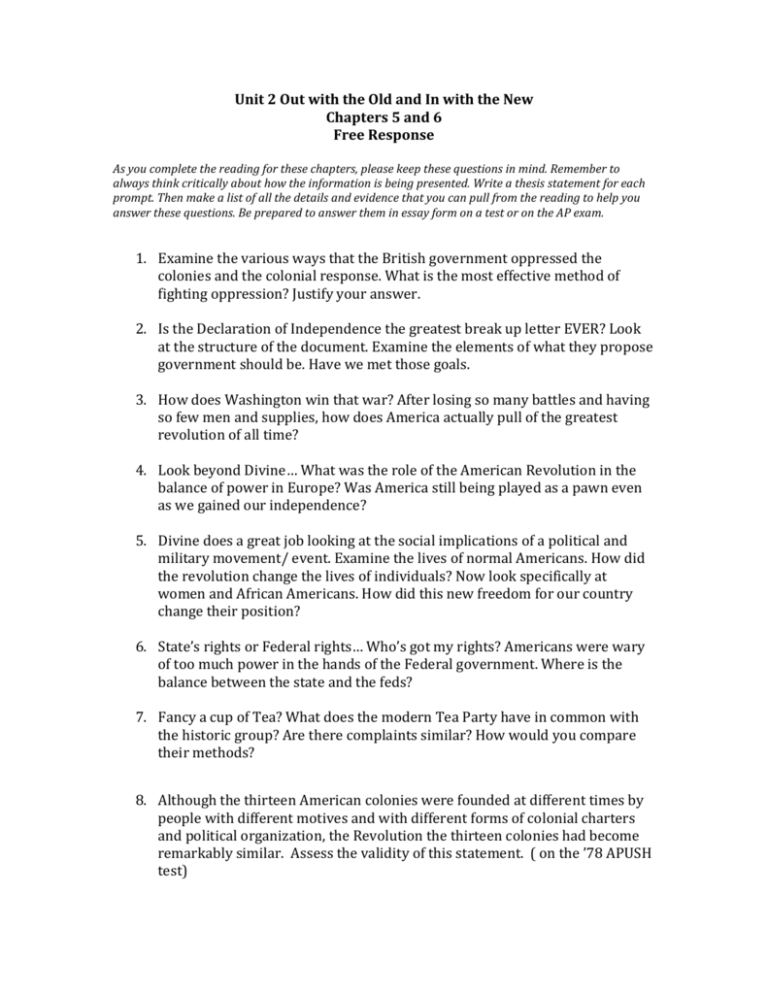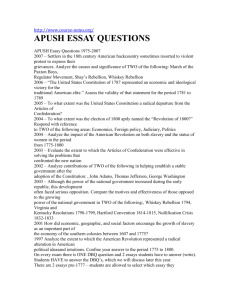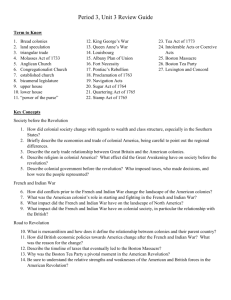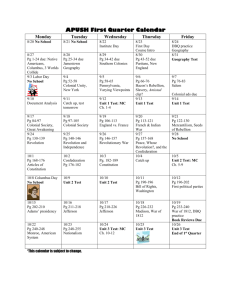File
advertisement

Unit 2 Out with the Old and In with the New Chapters 5 and 6 Free Response As you complete the reading for these chapters, please keep these questions in mind. Remember to always think critically about how the information is being presented. Write a thesis statement for each prompt. Then make a list of all the details and evidence that you can pull from the reading to help you answer these questions. Be prepared to answer them in essay form on a test or on the AP exam. 1. Examine the various ways that the British government oppressed the colonies and the colonial response. What is the most effective method of fighting oppression? Justify your answer. 2. Is the Declaration of Independence the greatest break up letter EVER? Look at the structure of the document. Examine the elements of what they propose government should be. Have we met those goals. 3. How does Washington win that war? After losing so many battles and having so few men and supplies, how does America actually pull of the greatest revolution of all time? 4. Look beyond Divine… What was the role of the American Revolution in the balance of power in Europe? Was America still being played as a pawn even as we gained our independence? 5. Divine does a great job looking at the social implications of a political and military movement/ event. Examine the lives of normal Americans. How did the revolution change the lives of individuals? Now look specifically at women and African Americans. How did this new freedom for our country change their position? 6. State’s rights or Federal rights… Who’s got my rights? Americans were wary of too much power in the hands of the Federal government. Where is the balance between the state and the feds? 7. Fancy a cup of Tea? What does the modern Tea Party have in common with the historic group? Are there complaints similar? How would you compare their methods? 8. Although the thirteen American colonies were founded at different times by people with different motives and with different forms of colonial charters and political organization, the Revolution the thirteen colonies had become remarkably similar. Assess the validity of this statement. ( on the ’78 APUSH test) 9. Despite the view of some historians that the conflict between Great Britain and its thirteen North American colonies was economic in origin, in fact the American Revolution had its roots in politics and other areas of American life. Assess the validity of this statement. (86) 10. This history of the present King of Great Britain is a history of repeated injuries and usurpation, all having in direct object, the establishment of an absolute tyranny over these States. Evaluate this accusation made against George III in the Declaration of Independence. (88) 11. Analyze the extent to which the American Revolution represented a radical alteration in American political ideas and institutions. Confine your answer to the period 1775 to 1800. (97) 12. Analyze the degree to which the Articles of Confederation provided an effective form of government with respect to any TWO of the following: Foreign relations Economic conditions Western lands ( 96) 13. The Bill of Rights did not come from a desire to protect the liberties won in the American Revolution, but rather from a fear of the powers of the new federal government. Assess the validity of the statement. (91) 14. Evaluate the relative importance of the following as factors prompting Americans to rebel in 1776: Parliamentary taxation British military measures Restriction of civil liberties The legacy of colonial religious and political ideas (92) 15. In the two decades before the outbreak of the American Revolutionary War, a profound shift occurred in the way many Americans thought and felt about the British government and their colonial governments. Assess the validity of this statement in view of the political and constitutional debate of these decades. (89) 16. What evidence is there for the assertion that the basic principles of the Constitution were firmly grounded in the political and religious experience of America’s colonial and revolutionary periods. (84)











